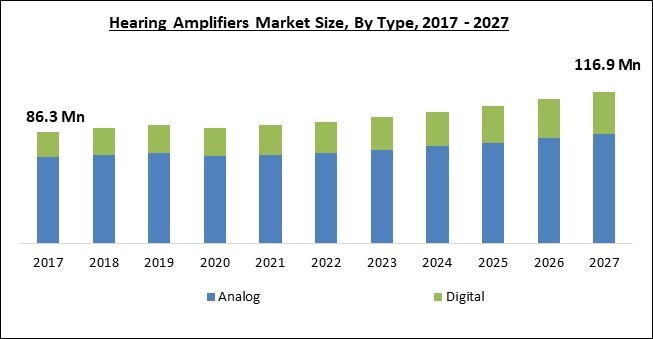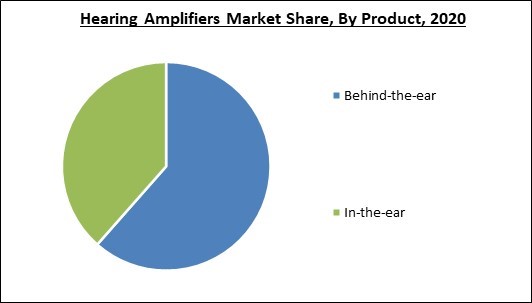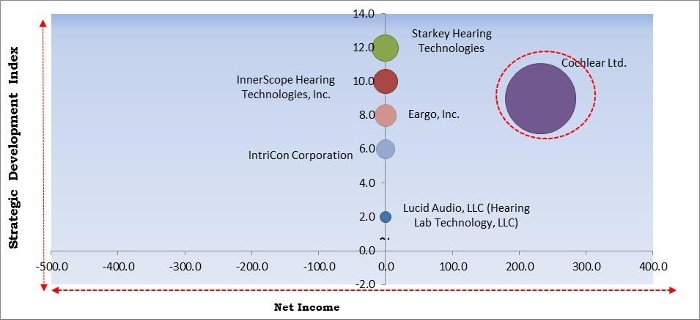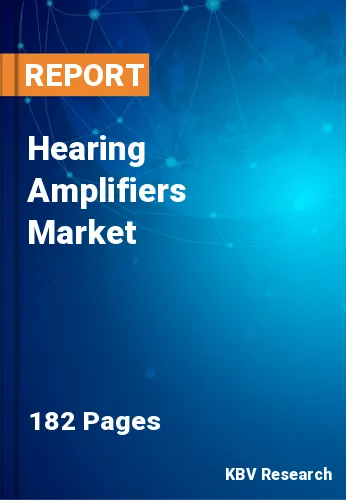The Global Hearing Amplifiers Market size is expected to reach $116.9 million by 2027, rising at a market growth of 4.3% CAGR during the forecast period.
Hearing loss is a prevalent condition that affects older persons and is increasing in prevalence, with symptoms appearing in patients as young as 40 years old. In addition, a variety of medical diseases can cause hearing loss. Additionally, ongoing studies reveal a link between age-related hearing loss and the development of risk of cognitive impairments, physical dysfunction, increased hospitalization rates, poor quality of life, and even mortality.
Hearing amplifiers have recently been customized to meet the needs of the elderly population, which improves hearing and makes the sound louder and more audible by decreasing distracting external voices. According to the World Health Organization, over 466 million individuals worldwide suffered from hearing loss in 2018, with the majority of these people being aged 50 and up. As a result, the rise in the market for hearing amplifiers will be aided by the growing elderly population.
The growing number of infants born with sensorineural hearing loss, as well as the efficacy of cochlear implants in correcting these hearing abnormalities in children, are expected to propel the paediatrics segment forward. Furthermore, the World Health Organization estimates that roughly 34 million children globally suffered from hearing loss in 2018. South Asia has the greatest rate of debilitating hearing loss.

The global hearing amplifiers market has been significantly damaged by the coronavirus pandemic. People are defending themselves during the COVID-19 emergency by social isolation, wearing masks, and washing their hands frequently. According to a new survey by the Hearing Health Foundation, more than 87 percent of people with hearing impairments have trouble communicating. Additionally, these characteristics are making it more difficult for people with hearing loss to communicate, which hampered the demand for hearing amplifiers during the pandemic period.
The outbreak of the COVID-19 pandemic had a detrimental impact on the market for hearing amplifiers. Hearing-impaired hospital patients face challenges as a result of the pandemic. During the pandemic, the use of masks rose, making it more difficult for persons who rely on lip-reading and facial expressions to communicate. Many hospitals have banned translators and visitors due to social alienation, and instead offer patients video conferencing with hearing aids to address market growth limits.
Hearing aid technology has advanced dramatically in the last few years. Smart technologies and the introduction of digital platforms in tiny devices have assisted various patients in overcoming their issues and improving their hearing experience. In addition, hearing aids that are digital are being brought to the market. Smartphone compatibility, Bluetooth connectivity, high sound processing, artificial intelligence (AI), rechargeable batteries, and the most recent tinnitus masking have pushed the hearing device's capabilities to new heights.
Major market players can benefit from emerging economies such as India, South Korea, Malaysia, Vietnam, Africa, and Middle Eastern countries such as Israel, Saudi Arabia, and the United Arab Emirates. This is because of the low regulatory hurdles, advancements in healthcare infrastructure, an increasing patient population, and rising healthcare expenditures. In addition, regulatory rules in the Asia Pacific area are more flexible and pro-business than those in industrialized countries. This, combined with increased rivalry in mature regions, has prompted major players in the hearing aids business to concentrate their efforts in emerging markets.
Many people find it difficult to acknowledge that they have a hearing loss and never get a hearing test done. In addition, many people are also hesitant to utilize these products because of the social stigma attached to them. According to Cochlear Ltd.'s State of Hearing Report 2019, over 92 percent of respondents see hearing as a key aspect in sustaining the overall quality of life. However, just 37% have had a hearing test in the last two years. According to the FDA, roughly 37.5 million persons aged 18 and up have difficulty hearing without a device, with symptoms ranging from "a little trouble" to "deafness."

Based on the Product, the Hearing Amplifiers Market is bifurcated into Behind-the-ear and In-the-ear. The In-the-ear segment acquired a significant revenue share of the Hearing Amplifiers Market in 2020. This is due to their high connection, comfort, efficiency, and ease of use. As a result, these amplifiers are more popular, thereby boosting the growth of the segment.
On the basis of Type, the Hearing Amplifiers Market is divided into Analog Hearing Aids, and Digital Hearing Aids. In 2020, the Analog segment held the biggest revenue share of the Hearing Amplifiers Market. This is due to increased awareness, an increase in the senior population, and awareness of treatment choices. In addition, continuous sound waves are amplified by analog hearing aids. All sounds (such as speech and noise) are amplified in the same way using these hearing aids.
Based on the Distribution Channel, the Hearing Amplifiers Market is segmented into Hospital Pharmacies, Online Pharmacies, and Others. The Online Pharmacies segment obtained a significant revenue share of the Hearing Amplifiers Market in 2020. This is because of the availabilities of advanced and latest products on these online amplifiers. Moreover, the high internet penetration around the world has boosted the growth of this segment.
| Report Attribute | Details |
|---|---|
| Market size value in 2020 | USD 89.4 Million |
| Market size forecast in 2027 | USD 116.9 Million |
| Base Year | 2020 |
| Historical Period | 2017 to 2019 |
| Forecast Period | 2021 to 2027 |
| Revenue Growth Rate | CAGR of 4.3% from 2021 to 2027 |
| Number of Pages | 182 |
| Number of Tables | 334 |
| Report coverage | Market Trends, Revenue Estimation and Forecast, Segmentation Analysis, Regional and Country Breakdown, Competitive Landscape, Companies Strategic Developments, Company Profiling |
| Segments covered | Product, Type, Distribution Channel, Region |
| Country scope | US, Canada, Mexico, Germany, UK, France, Russia, Spain, Italy, China, Japan, India, South Korea, Singapore, Malaysia, Brazil, Argentina, UAE, Saudi Arabia, South Africa, Nigeria |
| Growth Drivers |
|
| Restraints |
|
By Region, the Hearing Amplifiers Market is analyzed across North America, Europe, APAC, and LAMEA. In 2020, North America emerged as the leading region in the overall Hearing Amplifiers Market. This is because of the growing senior population and increasing incidences of deafness in this region. According to Johns Hopkins University experts, the number of persons with hearing loss is anticipated to double by 2060.
Free Valuable Insights: Global Hearing Amplifiers Market size to reach USD 116.9 Million by 2027

The major strategies followed by the market participants are Partnerships. Based on the Analysis presented in the Cardinal matrix; Cochlear Ltd. are the forerunners in the Hearing Amplifiers Market. Companies such as Starkey Hearing Technologies, InnerScope Hearing Technologies, Inc., Eargo, Inc. are some of the key innovators in the Market.
The market research report covers the analysis of key stake holders of the market. Key companies profiled in the report include Beurer GmbH, Lucid Audio, LLC (Hearing Lab Technology, LLC), InnerScope Hearing Technologies, Inc., Intricon Corporation, Otofonix Hearing Solutions, MDHearingAid, Eargo, Inc., Starkey laboratories, Inc., Sound World Solutions, Inc., and Cochlear Ltd.
By Product
By Type
By Distribution Channel
By Geography
The global hearing amplifiers market size is expected to reach $116.9 million by 2027.
Integration of advanced technologies are in high demand are driving the market in coming years, however, low willingness among patients to take a hearing test limited the growth of the market.
Beurer GmbH, Lucid Audio, LLC (Hearing Lab Technology, LLC), InnerScope Hearing Technologies, Inc., Intricon Corporation, Otofonix Hearing Solutions, MDHearingAid, Eargo, Inc., Starkey laboratories, Inc., Sound World Solutions, Inc., and Cochlear Ltd.
The Behind-the-ear market acquired maximum revenue share in the Global Hearing Amplifiers Market by Product in 2020, and would continue to be a dominant market till 2027.
The Digital market shows high growth rate of 6.2% during (2021 - 2027).
The North America market is generating high revenue in the Global Hearing Amplifiers Market by Region in 2020, and would continue to be a dominant market till 2027.
Our team of dedicated experts can provide you with attractive expansion opportunities for your business.

